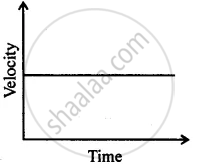Advertisements
Advertisements
Question
Multiple choice Question. Select the correct option.
At the maximum height, a body thrown vertically upwards has :
Options
velocity not zero but acceleration zero.
acceleration not zero but velocity zero.
both acceleration and velocity are zero.
both acceleration and velocity are not zero.
Solution
acceleration not zero but velocity zero.
APPEARS IN
RELATED QUESTIONS
A train starting from a railway station and moving with uniform acceleration attains a speed 40 km h−1 in 10 minutes. Find its acceleration.
Give one example of a situation in which a body has a certain average speed but its average velocity is zero.
A motorcycle moving with a speed of 5 m/s is subjected to an acceleration of 0.2 m/s2. Calculate the speed of the motorcycle after 10 seconds, and the distance travelled in this time.
Derive the formula : v = u + at, where the symbols have usual meanings.
A car acquire a velocity of 72 km per hour in 10 second starting from rest. Find
(1) the acceleration,
(2) the average velocity, and
(3) the distance travelled in this time.
Can you suggest a real-life example about the motion of a body from the following velocity – time graph?

Area under a v – t graph represents a physical quantity which has the unit
Draw a velocity versus time graph of a stone thrown vertically upwards and then coming downwards after attaining the maximum height.
An electron moving with a velocity of 5 × 104 ms−1 enters into a uniform electric field and acquires a uniform acceleration of 104 ms–2 in the direction of its initial motion.
(i) Calculate the time in which the electron would acquire a velocity double of its initial velocity.
(ii) How much distance the electron would cover at this time?
When will you say a body is at uniform acceleration?
